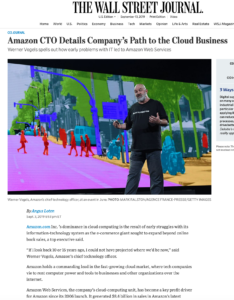The Wall Street Journal’s article “Amazon CTO Details Company’s Path to the Cloud Business — Werner Vogels spells out how early problems with IT-led to Amazon Web Services” by Angus Loten is an excellent recap of the history of how Amazon started their cloud computing business, AWS. In it, Werner Vogels the CTO of Amazon comments that in 2004 “We basically had one big piece of software and a whole set of databases related to it that were holding us back from moving faster,” he said, adding that “any changes made to the database needed to go through 10 levels of approvals because so many things would be impacted by it.” During that time, at Amazon, we were experiencing both stability problems and too much friction in software development. There was complexity, dependencies, and a lack of accountability between software teams in order to operate and innovate. The situation was untenable.
”We realized we needed to give our teams a bit more independence, and the only way to do that was to break off this big monolith into little pieces,”
It’s a great story. But what are the lessons that EVERY business leader can take from this story?
Think Like Amazon
In Think Like Amazon: 50 1/2 Ideas to Become a Digital Leader, I break out the strategies, tools and beliefs which create Amazon’s system for strategy, innovation, operational excellence and leadership development. What should every leader take from the story of Amazon’s path to the cloud business?
Are You Willing to Be Misunderstood (Idea 11): The most impactful and underappreciated aspect of innovation is challenging common and long-held assumptions about how things work. When you create an alternative to these assumptions, expect many doubters. Amazon got a 7 year head-start on their AWS cloud business because the traditional technology companies doubted Amazon’s ability to be a leader.
Yes, You Are a Technology Company (Idea 19): Centralized IT serves one set of purposes for your enterprise. As more connected experiences are integrated into your products and services and more technology-enabled innovation is needed throughout, put technology resources closer to customers, and embed these into the business, where they are part of the team and product.
Architecture Is the Business Strategy (Idea 39): How a business designs, builds, and operates your data and technology architecture matters, and it will affect the value of your business. Architecture defines how nimble you can be and what types of risks you have. These are business considerations, and you need to make sure you are deeply involved. Done under invest the time, talent, or budget.
The story of Amazon’s path to the cloud business in NOT about Amazon. The lessons are about your path to how you compete in the future!

